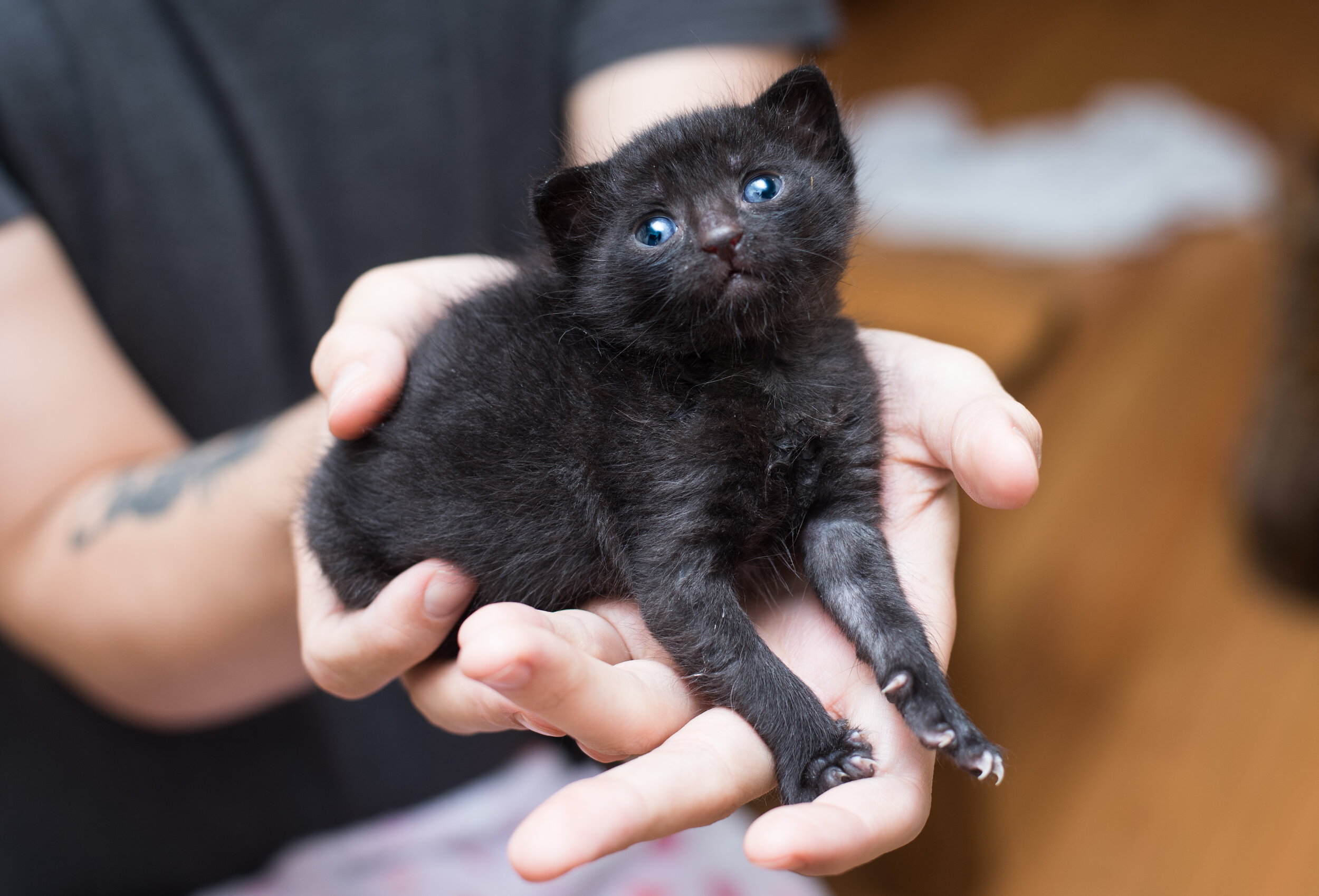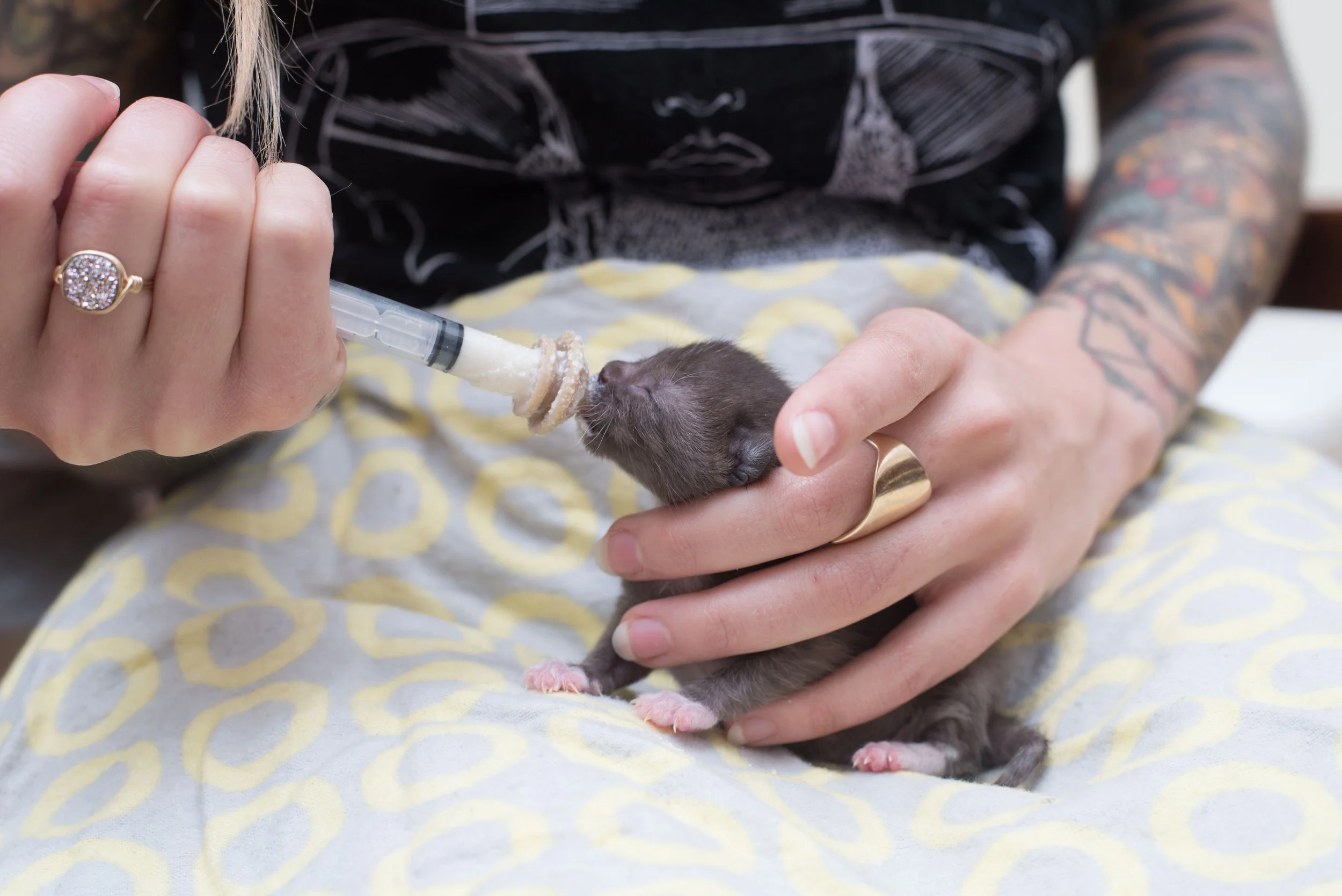Assessing Kitten Health
How to examine a kitten from nose to tail
When fostering kittens, you should always bring them to a veterinarian who can do a complete medical exam and provide you with guidance. It’s also important for you to assess the kitten’s condition daily at home so that you can determine if they need veterinary assistance! Below, you’ll find guidance on what to look for when assessing your kitten’s wellbeing.
Watch a 2 hour Advanced training on kitten assessment here:
Eyes
Are the eyes open or closed?
Closed eyes are normal for kittens under 2 weeks of age.
Closed eyes are not normal for kittens over 2 weeks of age, and may be a sign of infection.
Is there any crust, discharge, or swelling?
In cases of mild discharge, use a warm compress to clean the eye. Ask a veterinarian about an ophthalmic eye ointment. Watch my video about eye infections in kittens.
In cases of swelling, ulceration, or rupture, see a veterinarian as soon as possible. Watch my video about serum drops for severe infections.
If kitten is under 2 weeks old but the eye is swollen, he may have neonate ophthalmia. Watch my video about ophthalmia in neonatal kittens.
Nose
Is there any discharge, congestion, or sneezing?
Sneezing and clear discharge can be a sign of herpesvirus. Keep the nose clear, consider using a nebulizer, and talk to a veterinarian about antiviral medication.
Congestion and colorful discharge can be a sign of a respiratory infection, and you should see a veterinarian as quickly as possible to seek treatment options. In many cases the kitten will need to take a prescription antibiotic. Watch my video on how to give oral medication to kittens.
Mouth
Look at the gums.
Healthy gums will be pink in color.
White gums could be a sign that the kitten is hypothermic. Warm the kitten using a safe heat source.
White gums could also be a sign of anemia, especially if you know the kitten is at risk of blood loss due to a parasite like fleas. See a vet immediately.
Dark red gums could be a sign of sepsis or hyperthermia; go to a vet immediately.
Blue or purple gums could be a sign that the kitten is not getting enough oxygen; go to a vet immediately.
Touch the gums.
Healthy gums will be moist.
If the gums are tacky, the kitten may be dehydrated.
Look at the palate.
Is it in tact, or is there a cleft palate? If a cleft palate is seen, take caution when feeding to avoid aspiration, and go to a vet.
Look at the teeth.
Check to see if the lower canines are colliding with the palate. If so, the kitten may have a malocclusion. Schedule an appointment with a dental specialist. Watch my video to learn more.
Determine the kitten’s age. Watch this video to learn how to tell a kitten’s age based on their teeth.
Look at the tongue.
Check for ulcers. If ulcers are present, this may be a sign of calicivirus. Quarantine from other asymptomatic kittens, and see a veterinarian.
Ears
Look inside the ears.
A small amount of waxy residue is normal; clean with a cotton ball.
If dark, chunky residue is visible, the kitten may have ear mites. See a vet for a prescription medication that can help.
If the kitten is frequently shaking his head or scratching at his ears, see a vet.
Hair and Skin
Look at the fur.
If the fur is dirty, try to determine why. Stool? Blood? Dirt? Parasites? Watch my video to learn how to safely give a kitten a bath.
If the fur is missing patches, see a veterinarian. The kitten may have a flea allergy, mange, or ringworm.
Comb through the fur.
If dark specks are seen, the kitten likely has fleas. Watch my video to learn what to do.
If small white grains are seen, the kitten may have eggs or larvae. Watch my video to learn what to do.
Look at the skin.
If the skin is patchy, crusty, or red, see a veterinarian. Wear gloves with the kitten and keep separate from others until you can rule out ringworm and other contagious diseases.
If the skin has any evidence of injuries or abscesses, see a veterinarian immediately.
Chest/Respiratory
Observe the breathing.
A normal respiratory rate for a kitten is about 24-42 breaths per minute.
If the chest sounds rattly or congested, see a vet within 24 hours. The kitten may have pneumonia, which will typically require nebulizer treatment and antibiotic medication. Watch my video on how to safely give medication.
If the chest is flattened or curved inward, schedule an appointment with a veterinarian; she may have pectus excavatum.
If the kitten is breathing through the mouth, it is an emergency. Go to the nearest animal hospital immediately.
Listen to the heart.
A normal heart rate for a kitten is 220-300 beats per minute.
Abdomen
Observe the umbilical cord.
If absent, the kitten is likely over 5 days old.
If present and dry, the kitten is likely between 1 - 5 days old.
If present and wet, the kitten is less than 24 hours old.
If the area around the umbilical cord looks dark, red, vascular, or irritated, see a veterinarian immediately. The kitten may have umbilical sepsis which is life threatening without an antibiotic.
It’s important to keep the area around the umbilical cord clean with betadine. Never tug at the umbilical cord; allow it to fall off on its own.
Palpate the abdomen.
A healthy abdomen will be squishy and soft.
If the abdomen feels hard, the kitten may be constipated or bloated, which can occur for a number of reasons including the presence of parasites. Ensure that the kitten is dewormed and see a vet if the problem persists.
If the abdomen feels empty, and you can feel your finger on the other side of the flesh, the kitten is emaciated. Be careful about overfeeding or feeding too quickly; focus on hydration and gradually increase the volume of food over several meals.
If you can feel a large spherical organ like a water balloon inside, it may be a full bladder. Stimulate the kitten to urinate if under 1 month of age. If the kitten does not urinate within 12 hours, see a vet immediately to ensure that no infection is present and that the kitten does not require bladder expression.
Limbs
Examine the limbs.
If the kitten is limping, see a veterinarian. Limping can be a sign of an injury like a fracture, or can also be a sign of limping calicivirus.
If the limbs appear twisted, the kitten may have swimmer syndrome. Learn how to help kittens with twisted limbs.
If a limb is missing, try to determine if it is due to an injury or a congenital condition. If an injury is suspected, see a vet as soon as possible.
Examine the paws.
Non-retractable claws are normal during the first 4 weeks of life, after which the kitten should be able to retract the claws.
Check for patchy skin and hair loss between the toes, where ringworm is often visible if present.
Keep the claws trimmed starting at 4 weeks. Learn about how to trim kitten claws.
Stool and Urine
Examine the rectum.
If the rectum is protruding, the kitten may be constipated or obstipated. Seek veterinary help if you are unable to help the kitten pass stool with the advice in this article.
If the rectum appears to be open, the kitten may lack anal tone for a number of reasons including obstipation. Seek veterinary help quickly.
If no rectum is present, go to the nearest emergency hospital immediately. In some cases, atresia ani is treatable with surgical intervention, but in some cases it is not.
Examine the stool.
Healthy kittens will defecate anywhere from 1 to 4 times a day.
If the kitten does not defecate for 36-48 hours, they may be constipated and in need of veterinary assistance. Read about constipation.
If the kitten has diarrhea, see a vet quickly for a fecal exam. Causes of diarrhea can include parasites, viruses, absorption issues, and other illnesses. Diarrhea is always serious in kittens. Increase fluid intake when kittens have diarrhea.
If you’re having difficulty with a kitten’s stool, watch this extensive webinar on kitten poop problems.
Examine the genitals.
If discharge is present, see a veterinarian. The kitten may have an infection in need of an antibiotic medication. Learn how to give an antibiotic to a kitten.
If the skin around the genitals looks irritated, the kitten may have urine scald or fecal scald.
If the genitals look swollen or injured, watch for signs of sibling suckling. If a sibling is suckling on the kitten’s genitals, keep them separate to avoid further injury. Seek veterinary attention if needed.
Examine the urine.
Healthy urine is pale yellow.
Bright or dark yellow urine is generally a sign of dehydration. Increase oral fluids or give subcutaneous fluids.
Frequent, very dilute urine can be a sign of kidney disease.
If blood is present, see a veterinarian as soon as possible.
Behavior and Temperament
Observe the kitten’s energy.
A healthy kitten should be able to make age-appropriate movements. Learn about development during the first eight weeks.
A healthy kitten will sleep frequently, but should vocalize and lift the head if woken up.
If a kitten has severe lethargy or is unable to lift the head, it is an emergency. Go to your nearest animal hospital.
Observe the kitten’s movements.
Wobbly movements are normal in kittens under 4 weeks of age. If a kitten is wobbling after 4 weeks of age, see a veterinarian.
Trembling can be normal or a sign of illness. Many newborn kittens shake when attempting to walk or lift their head, but this should subside after the first few weeks. Trembling may also be normal after a kitten’s first time eating meat. Other instances of trembling should result in a vet visit. Watch this video to learn about why kittens shake.
Head pressing can be a sign of hypoglycemia. Ensure that the kitten’s sugar levels are regulated and see a veterinarian.
Temperature
Notice the kitten’s temperature.
Always provide a safe heat source for kittens under 4 weeks of age.
If a kitten has a temperature above 102.5°F, he has a fever. See a veterinarian.
If a kitten has a temperature under 97°F, she is hypothermic. Hypothermia can be caused by viruses, bacterial infections, and the environmental temperature. Note that it is unsafe to feed a hypothermic kitten. Gently and gradually work on bringing her temperature up before feeding, and see a vet if problem persists.
A comfortable environmental temperature for a kitten is between 75°F and 90°F.
Weight
Weigh the kitten at least once daily, if not at every meal.
A kitten’s weight should increase by at least 7-14 grams daily during the first weeks of life.
A kitten’s weight should always be on an upward trajectory, although it may fluctuate throughout the day. Note that it is normal for weight to decrease after urination/defecation.
If a kitten’s weight is plateauing or decreasing over the course of a day, please see a vet. Weight loss is a major indicator of a health issue in young kittens.
When to Seek Veterinary Care
If your kitten is exhibiting sudden changes to any of the above, or if you have any concerns about their wellbeing, please see a vet as soon as possible. Time is of the essence when caring for tiny kittens, and it’s important for them to be seen by an experienced medical professional before symptoms progress.
Thank you for caring for these vulnerable felines! You’ve got this!
Recommended videos:




